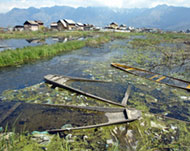Shrinking lake perturbs Kashmiris
Bulldozers flatten houses on the banks of Dal Lake in Indian-administered Kashmir while armed police officers in body armour stand guard.

Despite the show of force, this is not part of India’s fight against separatists who oppose New Delhi’s rule over the troubled but scenic Himalayan region.
Rather, the authorities are battling to save the freshwater lake, which tops most lists of the state’s major tourist attractions, but which has nearly halved in size over the past 30 years, a silent victim of neglect and illegal construction.
Tanveer Jahaan, who heads the state’s Lakes and Waterways Development Authority, says that for decades people living on and around the lake, which is fed by springs emerging from surrounding hills, have illegally dumped soil into its waters and built homes.
“We may not be able to recover the whole area of the lake, but we are hopeful of adding at least 3-4 sq km and improving its water quality,” Jahaan said.
Reclaimed land
Environmental campaigners say Dal – which dominates Srinagar, the summer capital of the state of Jammu and Kashmir and has for centuries inspired local lovers and poets – has shrunk from 25 sq km to 13 sq km since the 1980s.
 |
|
Pinewood houseboats are a |
Historical records estimate the lake stretched over 72 sq km in the 13th century.
Now officials are fighting back.
As homes built on reclaimed land are levelled, government workers strip away soil from the lake’s edge, allowing the waters to spread once again.
On a roadside nearby a billboard reads: “Save Dal, Save Kashmir.”
Lull in conflict
Separatists opposed to India’s rule over nearly half of Kashmir have waged an insurgency that has killed more than 45,000 people since 1989 and devastated the region’s tourism-dependent economy.
But a two-year-old peace process between India and Pakistan, both of which claim the region, has led to a drop in violence and visitors have begun to return.
|
“I believe what the heart is to the body, Dal is to Kashmir… At any cost, we have to win this battle and save it” Parvez Ahmad, |
Last year, Kashmiris had their best tourist season in years with nearly 400,000 mainly Indian visitors bringing much needed income.
And, as no stay is complete without a few nights aboard one of Dal’s nearly 2000 ornate pinewood houseboats, the lake is now centre stage as Kashmiris hope for a brighter future.
With names such as Miss England and Duke of Windsor, the boats were built for British officials during colonial rule as Kashmir’s Hindu ruler banned outsiders from owning land.
Parvez Ahmad, a tour operator, said: “I believe what the heart is to the body, Dal is to Kashmir.
“The lake has been a showcase for Kashmir’s tourism. At any cost, we have to win this battle and save it.”
Demolishing homes is just part of the war being waged.
Pollution
The lake is also being choked by weed and algae that has flourished as untreated sewage from Srinagar’s homes and the houseboats, and thousands of tonnes of silt from hills stripped of trees, flow into the water every year.
 |
|
Weed, algae and tonnes of silt |
The weed and silt is now being removed by mechanical dredgers while workers in small wooden boats haul giant mounds of both from the lake, once a heaven for water skiers, backpackers, Bollywood film shoots and flocks of migratory birds.
“The biggest challenge is the rehabilitation of more than 50,000 people who live in and on and around the lake,” Jahaan said.
The authorities have begun shifting families into residential areas of Srinagar but for the more than 10,000 households that depend on the lake’s resources – from fishing to growing vegetables in floating gardens constructed from rafts of reeds – it has not been a easy move.
Abdul Rashid, 60, who last year moved to a residential colony built for lake-dwellers by the government, said: “Dal has given us our bread and butter for centuries.
“Our forefathers lived on it and so did we.”
Sewage treatment
The state government, vowing to urgently address the lake’s woes, is building six sewage treatment plants to protect the lake, while the houseboats are being equipped with floating sewage tanks.
For some it is not enough.
Zameer Ahmad of Global Green Peace, a Kashmir-based environmental organisation, said: “The government is too late and doing too little. Dal needs more attention immediately.”
Gulam Mohideen, a 68-year-old houseboat owner, added: “I always pray that Dal survives.
“Its health is important for Kashmiris who have seen a lot of bloodshed and destruction.”